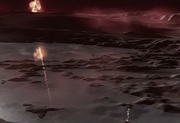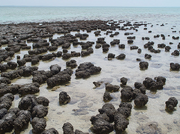Luna has always captivated Earth and influenced it for centuries. Countless people have called it "Earth's sister" and "Earth's copycat" because of how Luna came to be a habitable moon. This is how it all happened.
Early history[]

Artist's depiction of Theia, the Mars-sized object seconds before Earth impact.
The Earth was most likely created from space rubble that had collected into one massive ball of rock and magma. For a few million years the planet had been orbiting the Sun and being shaped into the Earth we know today. Then, 4.6 billion years ago, when the Earth was still a young molten planet, a protoplanet the size of Mars called Theia, (derived from the mythical Greek titan Theia, who gave birth to the Moon goddess Selene) impacted the Earth with enough force to let billions of tonnes of debris into orbit around the Earth.

Luna collecting debris from the Theia collision.
The debris had been flown into space and eventually, using the Earth's gravity, it formed a large ring around the Earth. This ring was similar to the rings of Saturn, but the debris was large enough to collect into a ball of rock after thousands of years. This ball of rock is what the ATL calls Luna, and less often "The Moon". Luna had orbited the Earth as well as orbiting it, like the Earth rotates around the Sun. But because of the Earth's immense gravitational pull, friction was created which slowed Luna's rotation down until it reached the state it is in now, where it always faces one side towards the Earth (the Near Side). This would cause problems later on for live to thrive on the other side when the far side of the moon didn't face the sun for 14 days, where temperatures would reach freezing points.
First Creation of Life[]

The Great Meteor Shower
Over the course of millions of years, millions of comets and meteors bombarded Luna as well as Mercury, Venus, Mars and the Earth. This period of time is known as the Late Heavy Bombardment, and informally "The Great Meteor Shower." All of these meteors and comets contained trace amounts of water, that after millions of years, added up to create seas and rivers, but because of Earth's gravity, these seas were raised enough to fill Luna with oceans. But all of these lakes and oceans wouldn't exist if it wasn't for the magnetic field. Without the magnetic field, the Sun's radiation would wipe Luna of any trace amounts of water.

The first puddles of water form on Luna's surface.
Water wasn't the only thing these meteors brought along. Minerals, compounds and amino acids were brought along, too, and once the pools of water were created, these mineral-containing meteors didn't crash onto the Earth's and Luna's solid surface, they landed hundreds of meters beneath the ocean.

The first microscopic life forms are brought to Luna by the same ones that were brought to Earth.
At the bottom of the ocean, life wasn't threatened by deadly Solar radiation. This meant that amino acids could collect to create the first microscopic life forms. They thrived underneath the cool temperatures and collected to make new bacterium and single-celled organisms. While this bacteria was forming, stromatolites were also forming. These stromatolites were the same stromatolites that harboured Earth's microscopic plant life that used photosynthesis for nutrition, making oxygen as a byproduct. After millions of years, life started to thrive in the oceans of Earth as well as Luna. It was only a matter of time before enough stromatolites expelled enough oxygen to create the first atmosphere. Radiated oxygen also meant an ozone layer to protect the inhabitants of deadly UV rays.

Stromatolites harboring microscopic plant life using photosynthesis, making oxygen as a byproduct.
This meant that life on Luna could evolve from the ocean to the surface. Enough animals evolved from flippers and gills and produced lungs, legs and spines. But the major difference between life on Earth and life on Luna was gravity. If the animal species were too small, they would have a harder time walking on the surface without being too lightweight. Evolution made it so that the structure of animals and, eventually "lunans," would have enough mass to be able to walk and crawl on the surface.
| |||||||||||||||||||

